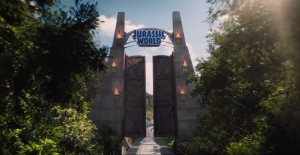What it Means to be a Fucking Human Being at The End of the Tour
by Matthew Cabe
(Photo courtesy of A24)
It’s ironic that a movie about David Foster Wallace spends most of its reels homing in on the guy interviewing him.
It’s ironic and it’s apt.
Because whether or not you connect with the lionized version of Wallace fashioned in the wake of his 2008 suicide, his writing was always concerned with other people.
Sure, it’s true much of his work showcased a deeply complex, perceptive and flawed psyche, but his goal was always to push readers outward toward ideas of what it means to be alive and why we do the things we do.
This could be said about any writer, by the way, but Wallace’s uncanny ability to write conversationally (esp. in his non-fiction) makes reading him an absurdly personal experience.
His was the last boisterous voice in literature and he was the last rockstar novelist. Our current world is too loud and fractured and options-based for a mere writers’ say to carry much weight among anyone other than readers.
And maybe Wallace wanted it that way. At least that’s partly what one version presented in James Ponsoldt’s The End of the Tour suggests.
As a fan(tod) it’s a hard pill to swallow because anyone who reads Wallace’s work or listens to his interviews knows how privy and opposed he was to the world becoming what it has become: fully corporatized and digitized, and nearly fully desensitized.
Funny how the world he rallied against in much of his writing and thinking was the same world that might’ve allowed him to exist more comfortably since, had he emerged today, he would’ve most likely remained anonymous to a vast majority of people.
And still it’s not that simple. That particularly Gen-X aversion to fame is only one of numerous versions of Wallace Ponsoldt and Jason Segel crafted when bringing David Lipsky’s book Although Of Course You End Up Becoming Yourself to the big screen.
One of Wallace’s more skeptical contemporaries, Bret Easton Ellis, recently suggested the Wallace in the film is yet another portrayal in a growing list of “sentimental narratives” (i.e. films that offer up characters with whom audiences can easily identify; e.g. Solomon Northup from 12 Years a Slave).
There exists no challenge in “sentimental narrative” films since they work only to extract sympathy from viewers.
Ellis never bought into the regular-guy persona Wallace swore was his real mid-western self. That in death Wallace has become what Ellis refers to as “Saint David” — that his writings have achieved gospel status in the literary world — only escalates Ellis’s opinion that Wallace’s self-presentation was inauthentic.
“‘The End of the Tour,’ is surprisingly easy to take even though it’s reverential to a fault,” Ellis wrote, and it’s a fair argument.
The film’s trailer, which works to deceive and becomes nauseating upon multiple viewings, has banked on not just a public awareness of Wallace’s likability, but a public acceptance and lauding of that likability. Wallace’s incessant down-playing of his own genius, in essence, was the cleverest (authentic or not) of his career choices because Americans like regular guys.
But to write the movie off as “an object of hero worship” as Ellis does is unfair, and Ellis — who thanks to his podcast has become one of the best minds discussing film today — forms his opinion of the film with too much distrust of Wallace himself.
Because while The End of the Tour does paint a likable and, yes, sentimental version of Wallace, it stops far short of hero worship to confront Wallace’s seemingly performative approach to not just celebrity but living itself.
In one scene, Jesse Eisenberg’s Lipsky — who accompanied Wallace on the last leg of his Infinite Jest book tour for a never-published Rolling Stone article — calls Segel’s Wallace out on his bullshit.
“You don’t crack open a thousand page book because you heard the author is a regular guy,” Lipsky says. “You do it because he’s brilliant.”
The underlying fear for Wallace in the film is that accepting his brilliance will alienate him. It’s a strange fear considering how fearful Wallace was of fame, and the film remains aware of that contradiction throughout; Lipsky never wavers from his suspicions even when it’s clear that he likes, is awestruck by, and yearns to be accepted by Wallace.
But it’s possible to be envious of a person, to like a person, and not-so-secretly wish you were that person even while you’re skeptical of his motives.
To misquote Wallace, that’s what it means “to be a fucking human being.”
So, really, the version of Wallace The End of the Tour presents is not Ellis’ “Saint David.” Sure, he’s likable, but he’s also overly competitive, pompous, childish and terrified.
If there’s one takeaway from the film it’s that we’re all contradictions and that’s alright. It’s a simple, definitely cliched takeaway, but D.T. Max — who wrote a biography of Wallace — argues that those banal truths were the ones Wallace gravitated to most.
“[H]is mental life had run a huge circuit through the most astonishing complexities to arrive at what many six-year-olds and nearly all churchgoers already understood,” Max wrote.
So it makes sense that (unlike the trailer) the film offers few staggering truth nuggets. Like good fiction it asks more than it answers (Ellis would disagree). But what it’s doing more than anything is offering up one man’s memories.
Nearly every scene in the film is blurred to points of annoyance and malfunction— just like memory. All is seen through Lipsky’s eyes, which are colored with pain, admiration, resentment, a little guilt, and frustration — direct results of the many Wallaces Lipsky met during his extended interview.
And while Segel’s approach to those versions of a man is limited (read: not nuanced) at best, he’s still astonishing as the late author.
Segel seamlessly incorporates Wallace’s signature facial ticks (evident in a Charlie Rose interview) that are born out of a genius’ obvious panic that he’s coming across as way too bookish (i.e. not a regular guy).
More than that, Segel’s voice is hauntingly similar to Wallace’s. In one scene, during a radio interview, it’s difficult to tell if what’s heard is Segel’s imitation or a recording of Wallace.
Usually biopic acting stifles the actor’s ingenuity because it requires a performance that’s largely impressionistic, but Segel manages to create a Wallace that achieves the rare feat of transcending replication that, in turn, denies distraction.
The End of the Tour is by no means perfect. It stumbles over itself as it attempts to introduce conflict through an all-too-familiar vulturous editor (Ron Livingston) and an all-too-clumsy inclusion of a near-bitter and needless love quadrangle.
Those scenes would’ve been rightly nixed if Ponsoldt (The Spectacular Now) were more confident in his directing abilities, which are above average.
And while the film doesn’t play fast and loose with dialogue — most is taken verbatim from Lipsky’s book — it does take liberties with the tone of some of those conversations, which is another attempt to build conflict that may or may not have existed.
Despite its faults, however, we’re still left with a visually nostalgic recreation of a conversation between two guys who’re way too smart for their own good, and it’s fascinating to watch.
It’s a genuine rendering of a man so hellbent on preserving his own genuineness that he becomes disingenuous the more he worries about being anything but genuine.
At one point Wallace asks, “What’s this story about in your mind?” Lipsky responds, “Just what it’s like to be the most talked about writer in the country.”
And The End of the Tour might be the closest we’ll ever come to knowing.






